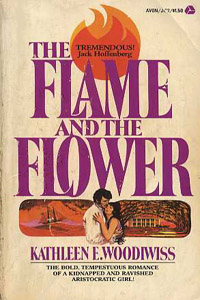The Best-selling Genre Nobody Reads
2/13/14 – THE BEST-SELLING GENRE NOBODY READS
“She gasped in surprise as he ripped the garment apart, spilling free the ripe fullness of her bosom before his hungering eyes.” (Come Love A Stranger, Kathleen Woodiwiss) 
Do you ever curl up with a big, juicy, historical romance? Did you just now roll your eyes at the question?
Romances – novels which focus on a growing romantic relationship between hero and heroine and end with them loving each other happily ever after – have been with us for ages. But the historical epic we’ve come to associate with the romance genre is only a little over forty years old.
In the early 1970s, romance readers had two options: short novels (around 200 pages each) known as category romances, set in contemporary times and available for about a month before replaced on the shelves or longer hardcover novels which could be either contemporary or historical. Both choices offered fairly uncomplicated plots and unsullied, dependent heroines.
All this changed when Avon editor Nancy Coffey fished a manuscript from her slush pile. The manuscript had already been rejected by agents and hardcover publishers: at 600 pages, it was too long for either category or hardcover publication. But Avon was a paperback imprint, and Coffey liked what she read. The Flame and the Flower was published in 1972. Its thirty-two-year-old author, Kathleen Woodiwiss, accepted a $1500 advance and 4% of the royalties. The book became the first single-title romance novel published as an original paperback. But more than that, The Flame and the Flower revolutionized the romance genre by featuring a strong heroine in an epic historical romance liberally sprinkled with steamy sex scenes. For the first time, the romance reader could share – in graphic detail – exactly what went on between the always-ravishing protagonists once that bedroom door closed.
The Flame and the Flower sold over 2.3 million copies in its first four years of publication. As its success blossomed, the popularity of “old school” chaste gothic romances waned. By 1978, over 4.5 million copies of The Flame and the Flower had been sold, and bookstore shelves were lined with book covers depicting half-dressed couples locked in passionate embraces against intriguing backgrounds.
And women everywhere – 93% of romance readers are women – began lying about whether or not they read this stuff. Because seriously, has anyone ever hastily tucked a copy of Pride and Prejudice behind their backs when someone unexpectedly enters the room?
Almost immediately he was on top of her, pinning down her writhing body, and it seemed that every move she made only abetted his intent. Her hair came loose and seemed to stifle her in its mass.
“No!” she gasped. “Leave me alone! Let me be!”
He chuckled and murmured against her throat. “Oh, no, my bloodthirsty little wench. Oh, no, not now.” (The Flame and the Flower, Kathleen Woodiwiss)
According to Business of Consumer Book Publishing 2013, romance fiction brought in approximately $1.438 billion in sales in 2012. That same year, romance was the top-performing category on various best-seller lists, including the New York Times, USA today, and Publishers Weekly. Clearly, somebody is reading these books, despite the fact that nobody wants to ‘fess up. Why does the poor genre continue to get no respect? No matter how strong the stats, romance still inspires derision. Critics point out that there’s not much point in reading a story where one already knows the outcome. Duly noted. But why are even fans of the books embarrassed to admit that they buy, borrow, or read anything remotely related to what is pejoratively called a “bodice-ripper”?
In search of an answer to this, I conducted a totally unscientific poll and asked around. My question? “IF you read romances…” (because remember, nobody actually does) “…would you tell people?” Not surprisingly, all but one person said no. But some of the reasons were interesting, and most fell into one of these categories:
“I would be embarrassed about wasting so much valuable time.”‘
“I would feel judged, like people assumed I just sat around all day in my robe, eating chocolates.”
“I would feel stupid and unsophisticated. There is nothing intellectual about those books.”
Yet romance continues to fly off the shelves. Is this the epitome of a guilty pleasure, something one enjoys despite the feeling that it isn’t held in high regard?
Not to worry. With the anonymity of e-readers, nobody on that crowded bus can tell what you’re reading, anyway. (I’m talking to you, Fifty Shades of Grey reader in the corner.)
“My bodice!” gasped Constance. “Trevor, you have ripped my bodice!”
“By God, yes! And I shall do much more.” She felt his breath on her neck, steamy and moist. “I am a man who gets what he wants and wants what he gets!”
Her knees crumpled beneath the influence of his strong grip. “And…and you want me?” she asked tremulously.
“Yes, you little strumpet. Even though I am the fourth Earl of Haversleigh and you are but a wanton piece of fluff, I want you more than I have ever wanted any woman! And do not forget: I detest refusal, so I never ask!” (um…ok. So I made this one up. Whatever.)
Happy Valentine’s Day!
Jill Morrow
Jill Morrow is the author of ANGEL CAFE (Simon & Schuster 2003) and THE OPEN CHANNEL (Simon & Schuster 2005). Her next novel, NEWPORT (HarperCollins/WilliamMorrow), will be published in summer of 2015. Jill has enjoyed a broad spectrum of careers and opportunities, from practicing law to singing with local bands. She lives in Baltimore, Maryland.
- Web |
- More Posts(13)